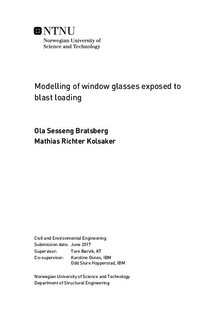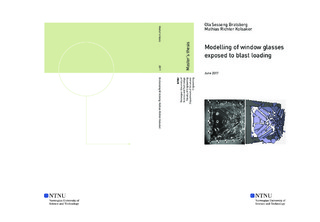| dc.contributor.advisor | Børvik, Tore | |
| dc.contributor.advisor | Osnes, Karoline | |
| dc.contributor.advisor | Hopperstad, Odd Sture | |
| dc.contributor.author | Kolsaker, Mathias Richter | |
| dc.contributor.author | Bratsberg, Ola Sesseng | |
| dc.date.accessioned | 2019-09-11T08:34:46Z | |
| dc.date.created | 2017-06-10 | |
| dc.date.issued | 2017 | |
| dc.identifier | ntnudaim:17781 | |
| dc.identifier.uri | http://hdl.handle.net/11250/2614892 | |
| dc.description.abstract | Flying glass fragments are one of the main causes of casualties and injuries during terror attacks with explosives, due to fragments shooting through the air. A common way to increase the blast security in windows is to add a laminate or an interlayer between two or more glass panes creating laminated glass. One of the goals of the interlayer is to prevent fragments from loosening, through adhesive properties in the laminate glass connection. In the construction of the new governmental complex in Oslo, Norway, laminated glass windows are to be used as a measure to increase blast security.
The numerical modelling of laminated glass has proven to be challenging. This thesis aims to increase the understanding of laminated glass properties and the response during quasi-static and blast loading. A study of the possibilities and limitations of numerical modelling of laminated glass in quasi-static and blast loading simulations was also conducted in the thesis. Point tracking DIC analysis was used to capture the response in the specimens subjected to blast load
Experiments were conducted in the SIMLab research facilities at NTNU. Four-point bending tests were carried out on laminated glass specimens to study the fracture strength during quasi-static loading, and blast tests were conducted on both regular float glass and laminated glass in the SIMLab shock tube to study the response during blast loading. The data recorded during the experiments were interpreted, and the results were used in the development of numerical models of the experiments. The tests were modelled with an explicit non-linear FEM code in IMPETUS Afea Solver, with node splitting used to describe fracture. Parameter studies were conducted to examine the effect of e.g. mesh size, element type and properties of interaction between PVB and glass.
From the quasi-static bending tests, it was found that the fracture stresses in the glass varied due to stochastic material properties in float glass. It was found a higher fracture strength in larger samples than the small samples. In the blast tests, the fragment size was smaller in the laminated glass than in the float glass. In the numerical modelling of the glass panes, it was found that node splitting and pentahedron elements gave good results describing crack propagation. Material modelling of the PVB in IMPETUS and interaction between glass and PVB proved challenging and needs further research. | en |
| dc.language | eng | |
| dc.publisher | NTNU | |
| dc.subject | Bygg- og miljøteknikk, Beregningsmekanikk | en |
| dc.title | Modelling of window glasses exposed to blast loading | en |
| dc.type | Master thesis | en |
| dc.source.pagenumber | 170 | |
| dc.contributor.department | Norges teknisk-naturvitenskapelige universitet, Fakultet for ingeniørvitenskap,Institutt for konstruksjonsteknikk | nb_NO |
| dc.date.embargoenddate | 2020-06-10 | |

